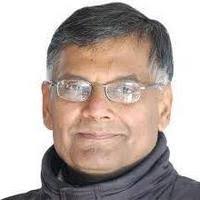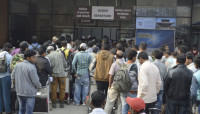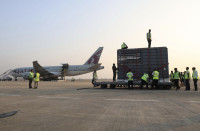Columns
Rationalising Nepal-India relationship
Bilateralism is necessary but no longer sufficient for friendly relations in a globalised world.
CK Lal
By returning the Bill to Amend the Citizenship Act to the federal Parliament for a review, President Bidya Devi Bhandari had put a huge question mark on the cross-border "Roti-Beti" relationship. The parliamentary majority may force her to authenticate the bill, but President Bhandari has succeeded in publicising the prejudices of the dominant HAMNS (Hindu, Aryan, Male and Nepali Speaker) mainstream.
A significant section of the haute, mean and lumpen bourgeoisie in the country feels that Indian brides need to be given some kind of cooling off period before being granted citizenship through marriage. Khadga Prasad Sharma Oli is the ethnonational supremo of the dominant Khas-Arya community. Supremo Sharma Oli voiced the concerns of all ethnonationalists when he opined that identity papers could be issued to the newly-weds before they become eligible for citizenship that would still bar them from aspiring for certain high offices.
Prolonged overuse has reduced the efficacy of the Roti-Beti description. Relations through marriage have been on a steady decline for a long time. Social, economic and cultural integration in Nepal has reduced the necessity to look for partners across the border. Acceptance of inter-community and inter-caste marriages have made it possible for highly-educated persons to find equally competent mates within the country. Since Madheshis are widely perceived to be lower grade citizens, the upper crust of Bihar and Uttar Pradesh states in India is no longer interested in martial relationships across the border.
Prime Minister Narendra Modi may declare that without Sita of Janakpur, even Ram of Ayodhya is incomplete, but the fact is that the social dimension of the much-vaunted special relationship has become extremely weak. Religious ties that bind are still strong, but securitisation of the land border and formalisation of air travel may begin to have a detrimental impact. Immigration authorities at international airports in India look suspiciously upon identity cards and demand to see the passport of Nepali visitors.
The Roji-Roti (wage and livelihood) bond is still strong. Unskilled labour from the mountains of western Nepal find it easier to look for employment in Uttarakhand and Himachal Pradesh. There is a long tradition of youths from the mid-hills of central Nepal to travel as far afield as Maharashtra, Tamil Nadu, Kerala and Gujarat in search of work. Seasonal migration of agricultural labour from Madhesh to Haryana and Punjab has almost stopped, but more Madheshi engineers, doctors and managers work in India now than ever before. An equal number of Indians, if not more, can be found working in Nepal in different occupations. Increasingly, this two-way traffic is also under considerable strain.
It's no longer easy to send money from Indian cities back home to Nepal. Formal channels require a tonne of documentation. The ban on circulation of higher denomination Indian currency notes in Nepal has made carrying cash a cumbersome and risky exercise. Remitting wage savings or repatriation of profits from small enterprises from Nepal to India has to be channelled almost entirely through unofficial operators with all attendant costs and risks.
It's all very well for Indian Defence Minister Rajnath Singh to avow that he is ready to bow his head if needed for good Nepal ties, but pleasing the ruling elite in Kathmandu will be meaningless when the people-to-people relationship between the two countries has been stretched beyond a point.
Romantic perceptions
It's almost mandatory for the social elite in both countries to ground the importance of bilateral relationship in myth, history and memory. Prime Minister Modi loves to hark back to the Shaivite glory of Pashupatinath, Vaishnavite connection with Muktinath, the centrality of Janakpur in the hallowed lore of Ramayana and the birth of the future Buddha as Prince Siddhartha in Lumbini. Prime Minister Sher Bahadur Deuba travels to Varanasi to emphasise the long association of the Nepal Durbar with Kashi Vishwanath.
King Prithvi Narayan Shah is believed to have received divine inspiration for his "asali Hindusthana" dream, procured modern weaponry to realise his ambitions and gone back as a victor to acquire Kashyap Gotra from high priests of Kashi. The gurus along the banks of Papnashini (annihilator of sins) Ganga River have been imparting knowledge to seekers from the entire subcontinent for millennia. The importance of the place can be gauged from the fact that the beginning of the search for knowledge at the Bratbandha (thread of sacred avowal) ceremony is called "going to Kashi"!
In the imagination of a section of the Indian elite, Nepal was a place of Hindu power and purity. In November 1940, VD Savarkar—the ideologue-in-chief of the present ruling regime in India—romanticised that the king of Nepal would emerge "as the Defender of the Hindu Faith and the commander of Hindu forces", mobilising "Hindu rifles" to "spit fire and vengeance in defence of Hindu Honour" and might even make "a bid for the Imperial throne of Hindusthan".
In 1942, socialist revolutionaries such as Rammanohar Lohia and Jayprakash Narayan held training camps for freedom fighters in the wilderness of the Koshi delta. When the Rana regime arrested them at the behest of British-Indian authorities in May 1943, they were freed from Hanumannagar prison with the help of a Madheshi landlord Rameshwar Singh and his team.
Lohia and Narayan remained lifelong friends of Nepal. Lohia was arrested for the first time in independent India in May 1949 while protesting against Rana rule in New Delhi. Participation was reciprocal. BP Koirala and Manmohan Adhikari along with various lesser known Nepalis worked with Mahatma Gandhi and Subhas Chandra Bose for the independence of India and suffered incarceration.
Shared dreams of democratic socialism in South Asia continued to inspire politicos across the border as Nepali activists found shelter in India through the 1960s, and many Indian democrats crossed over to Nepal during the dreaded Emergency (1975-77) when it was unsafe for freedom lovers to remain free in New Delhi. Perhaps Pradip Giri, 75, was one of the last of the generation of socialists that dreamt of a United States of South Asia materialising some day. The Akhand Bharat rhetoric of the Rashtriya Swayamsevak Sangh forecloses all such possibilities.
Ground realities
The Treaty of Peace and Friendship 1950 is the foundational document of the special relationship. The formation of the Eminent Persons' Group, which was sometimes ridiculed as Eminent Pahadi Group because it had no Madheshi representation, was a recognition of the fact that the archaic pact had outlived its utility. Ironically, its report itself has become an irritant.
The tripartite agreement sought to give continuity to the over two-centuries old gallantry of the Gorkha Rifles of the Indian Army. The recently launched Agniveer scheme of recruiting contractual service personnel goes against the very idea of regimental glory. Nepal had proposed a review of the agreement previously and objected to the Agnipath route recently. India has unilaterally declared it dead by continuing with the recruitment.
General Manoj Pande, the 29th Army Chief of India, will be in Kathmandu next week to receive an honorary commandership of the Nepali Army from President Bhandari. The Agniveer Gorkhas will make such exchanges of honours between two armies in the future purely ceremonial.
Good neighbourly relationship requires that gooey sentimentality be replaced with grounded practicality irrespective of the short-term consequences. The Nepal-India relationship can no longer ignore the combined shadow of the Chinese Dragon and the American Eagle in South Asia. Bilateralism is necessary but no longer sufficient for friendly relations in a globalised world.




 19.12°C Kathmandu
19.12°C Kathmandu













%20(1).jpg&w=300&height=200)

